Curious about the different types of beer? Whether you’re a beer enthusiast or a novice, understanding the variety of beer styles can enhance your appreciation and enjoyment. This guide breaks down the main types of beer, including ales and lagers, and dives into their unique characteristics and popular sub-types. Discover all there is to know about the different types of beer, and find your next favorite brew! Each type of beer offers a unique experience that can elevate your tasting journey.
In this comprehensive guide, you’ll discover that beer is primarily categorized into two types: ales and lagers. Ales are brewed at warmer temperatures using top-fermenting yeast, resulting in diverse styles such as pale ales, IPAs, stouts, and porters, each offering distinct flavors and aromas. On the other hand, lagers utilize bottom-fermenting yeast and are brewed at cooler temperatures, featuring styles like Pilsners, American lagers, and Bocks, known for their smooth and refreshing qualities. Understanding the characteristics of different beer types enhances your appreciation for their flavors, making beer versatile for various occasions, food pairings, and even culinary use.
Understanding Beer: Ales vs Lagers
Beer can be broadly categorized into two main types: ales and lagers, distinguished primarily by the type of yeast used during fermentation. This fundamental difference in the brewing process leads to a wide range of flavors and characteristics, making each type unique and appealing to different tastes.
Ales are usually brewed at warmer temperatures. This range is typically between 60-75 degrees Fahrenheit, and they use top fermenting yeast. This process allows the yeast to ferment at the top of the fermentation tank, imparting complex flavors that can be fruity, spicy, or even slightly sweet. The fermentation process for ales is relatively quick, often resulting in a beer that is ready to drink in a few weeks.
In contrast, lagers are fermented at cooler temperatures, between 35 to 50 degrees Fahrenheit, using bottom fermenting yeast. This yeast ferments at the bottom of the tank, producing a clean and crisp taste. The cooler fermentation process takes longer, often several months, but the result is a beer that is smooth and refreshing.
The type of yeast and fermentation process not only affects the flavor but also the appearance and mouthfeel of the beer. Ales often have a fuller body and more pronounced flavors, while lagers are known for their clarity and lightness. These differences make ales and lagers suitable for different occasions and food pairings, adding to the versatility of beer as a beverage.
Understanding these fundamental differences between ales and lagers is the first step in appreciating the diverse world of beer. Examining specific styles reveals how these basic principles create a wide array of flavors and experiences.
Top Fermenting Yeast: Ales
Ales use top-fermenting yeast strains, which thrive at warmer temperatures. This type of fermentation, known as top fermentation, allows the yeast to rise to the surface during the brewing process, resulting in a wide variety of flavors. Fermentation temperatures for ales range from 60°F to 75°F, fostering complex flavors.
The use of top fermenting yeast imparts unique characteristics to ales. This yeast can produce fruity and spicy notes, adding depth and complexity to the beer’s flavor profile. Different yeast strains can also contribute to the diversity within ale styles, making each type of ale distinct. For example, English yeast strains tend to add subtle flavors, while other strains can produce more pronounced fruity or spicy notes.
Commonly classified ales include pale ales, IPAs, stouts, porters, and brown ales. These styles vary significantly in flavor, from the hoppy bitterness of pale ales to the rich, roasted flavors of stouts and porters. This variety makes ales incredibly versatile, appealing to a wide range of tastes and preferences.
The warm fermentation process not only influences the flavor but also the aroma and mouthfeel of the beer. Ales often have a fuller body and more pronounced flavors compared to lagers. This makes them perfect for pairing with hearty dishes or enjoying on their own as a complex beverage.
Bottom Fermenting Yeast: Lagers
Lagers are a type of beer that undergo bottom fermentation, distinguishing them from ales. This process involves fermenting at cooler temperatures, typically between 35 to 50 degrees Fahrenheit, using bottom-fermenting yeast (Saccharomyces pastorianus). The yeast ferments at the bottom of the tank, producing a clean and crisp taste that is characteristic of lagers.
Fermenting lagers at cooler temperatures results in a smooth, refreshing beer with a clear appearance. The extended fermentation time, often several months, allows the flavors to develop slowly, resulting in a well-balanced and refined beer. This makes lagers an excellent choice for those who prefer a lighter, more subtle beer.
Common types of lagers include Pilsners, Bocks, and Munich-style lagers, with notable origins tracing back to Germany. These styles each have unique characteristics but share the clean and crisp taste typical of lagers. The influence of German brewing traditions is evident in the meticulous brewing process and the emphasis on quality and consistency.
Their clean and crisp taste makes lagers versatile, suitable for various occasions and food pairings. From a light Pilsner on a hot summer day to a robust Bock in winter, lagers offer a refreshing experience. Knowledge of the brewing process and characteristics of lagers enhances appreciation for these popular styles.
Popular Ale Styles
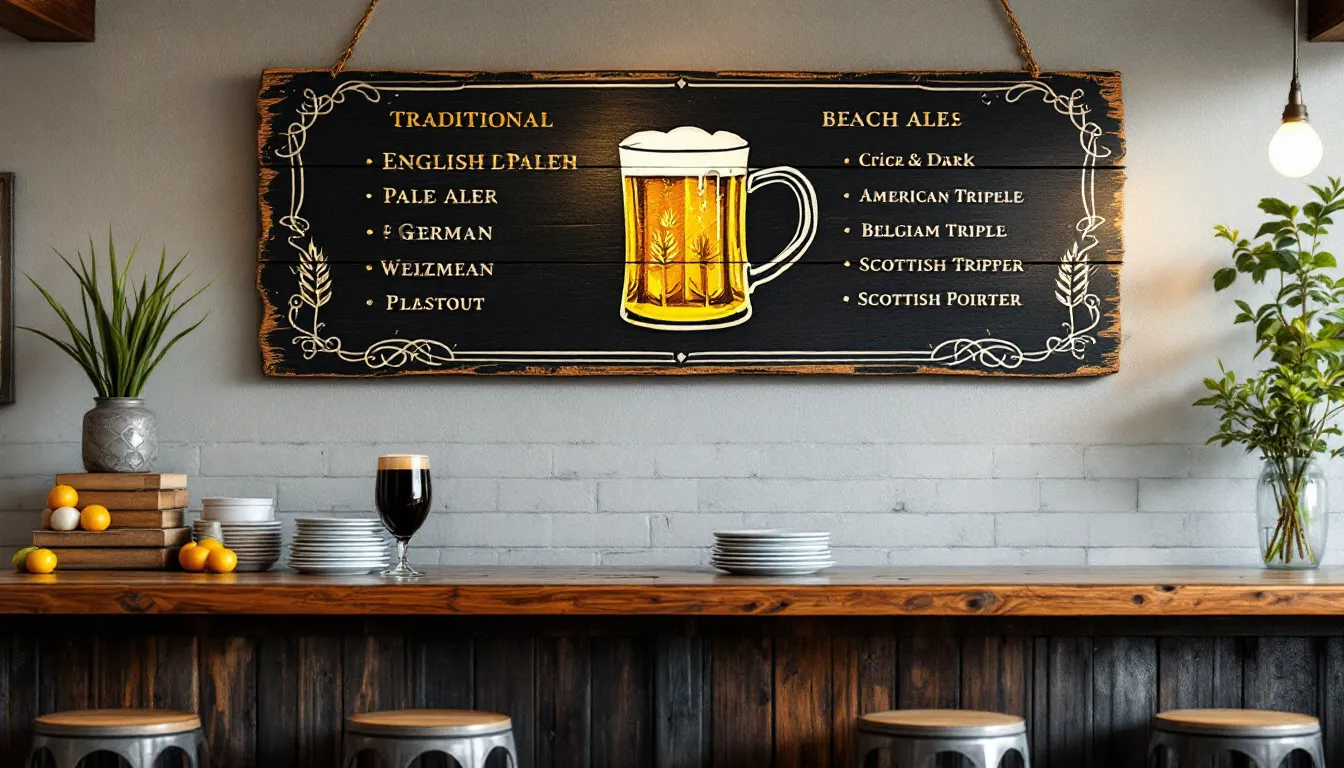
Ales are incredibly diverse, offering a wide range of flavors and aromas that cater to different preferences. From the hoppy bitterness of pale ales to the rich, roasted notes of stouts, each ale style brings something unique to the table. Understanding these styles can help you choose the perfect beer for any occasion and enhance your overall beer-drinking experience.
One of the reasons ales are so varied is the different yeast strains used in their production, which can impart a wide range of flavors, from fruity to earthy. This diversity makes ales a favorite among beer enthusiasts who enjoy exploring new tastes and styles. Ales are also known for their ability to complement a variety of foods, from hearty meats to lighter dishes like chicken and seafood.
We’ll explore some of the most popular ale styles: pale ales, IPAs, stouts, porters, and wheat beers. Each of these styles has its own unique characteristics and flavor profiles, making them distinct from one another. Knowing these differences enhances appreciation for the complexity and artistry of brewing each ale type.
First, we examine pale ales, known for balanced flavors and hop-forward profiles. Next, we’ll explore the bold and bitter IPAs, followed by rich and creamy stouts. Afterwards, we’ll look at smooth and flavorful porters, and conclude with refreshing, often citrusy wheat beers. Each subsection provides detailed information about the style, its history, and unique characteristics.
Pale Ale
Pale ales are characterized by their hoppy bitterness combined with a moderate malt sweetness, making them a balanced and versatile beer style. Blonde ale typically features a golden to amber color and a medium body, with flavors that can range from fruity to slightly roasted.
American-style pale ales, developed in the early 1980s, are known for their hoppier profiles and citrus undertones compared to their English counterparts. These beers often have a more pronounced hop bitterness and a lighter body, making them a refreshing and flavorful choice. In contrast, English pale ales tend to have a richer malt profile with earthy hop character, offering a more balanced and traditional taste. American pale ales are a popular choice among craft beer enthusiasts.
The flavor profile of pale ales includes malty notes, biscuit flavors, and a slightly roasted note, with a delicately bitter finish. This combination of flavors makes pale ales a popular beer style among beer enthusiasts who appreciate a well-balanced and easy-drinking beer.
Whether you prefer the hoppier American pale ale or the maltier English pale ale, both styles offer a delightful experience, either alone or paired with various foods.
India Pale Ale (IPA)
India Pale Ales (IPAs) are a popular beer style known for their bold hop flavors and higher bitterness, distinguishing them in the beer landscape. The origin of IPAs can be traced back to British pale ales brewed for transport to India during the colonial era. These beers were heavily hopped to preserve them during the long sea voyage, resulting in a distinctively bitter flavor. American breweries played a key role in the revival of IPAs, creating new variations and pushing the boundaries of hop usage.
IPAs are characterized by high hop bitterness, a robust flavor profile with citrus or herbal tones, and an IBU (International Bitterness Units) scale indicating greater bitterness levels. The high hop content gives IPAs their signature bitter taste, balanced by a strong malt backbone that provides sweetness and complexity.
There are several popular sub-styles of IPAs. These include American IPA, English IPA, Imperial IPA, New England Style IPA, and West Coast IPA. Each of these sub-styles has unique attributes, such as the hazy appearance and creamy mouthfeel of New England IPAs or the clear, crisp, and piney flavors of West Coast IPAs.
IPAs have become a favorite among craft beer enthusiasts who appreciate their bold flavors and the variety of hop profiles available. Whether you enjoy the citrusy notes of an American IPA or the balanced bitterness of an English IPA, there’s an IPA style to suit every palate.
Stout
Stouts are rich and creamy beers known for their dark profile and flavorful characteristics. They are brewed with roasted malts, which give them their distinctive dark color and complex flavors. Types of stouts include American stout, Irish dry stout, milk stout, oatmeal stout, and Russian Imperial stout, each offering unique tasting notes and textures.
An imperial stout is noted for its boldness, high alcohol content, and rich malt flavors. These stouts are often aged, allowing the flavors to develop and mature over time. Oatmeal stouts, on the other hand, are brewed with oats, which enhance the mouthfeel and create a smooth, silky texture.
Stouts feature tasting notes such as coffee, chocolate, and licorice, with a dark, roasted profile. The use of roasted barley and unmalted roasted barley contributes to these rich flavors, making stouts a favorite for those who enjoy bold and robust beers. Irish dry stouts, like the famous Guinness, are known for their dry, roasted malt flavors combined with hints of coffee, chocolate, and a roasted malt aroma.
Whether you enjoy the creamy texture of a milk stout or the intense flavors of an imperial stout, stouts offer a wide range of options for beer lovers who appreciate rich and complex beers.
Porter
Porters are defined by their use of roasted brown malts, giving them a rich malt character and a smooth mouthfeel. Originating in London, porters were popular among the working class for their robust flavors and satisfying nature. These beers are brewed with a variety of roasted malts, which contribute to their dark color and complex flavor profiles.
The flavor profile of porters is determined by the variety of roasted malt used, often featuring rich notes of roasted malt, chocolate, and coffee. This combination of flavors creates a beer that is both rich and smooth, with a medium-to-full body that is satisfying to drink.
Robust porters typically have a smooth mouthfeel and a medium-to-full body, making them a popular choice among those who enjoy darker beers. These porters often have a slightly higher alcohol content and more pronounced flavors compared to lighter beer styles.
Porters’ historical origin and rich flavors make them a fascinating and enjoyable beer style. Whether you prefer the smoothness of an English brown porter or the boldness of an American imperial porter, porters offer a wide range of flavors to explore.
Wheat Beer
Wheat beers are notable for their hazy appearance and are often brewed with a high proportion of unmalted wheat, contributing to a smooth and refreshing taste. These beers are typically light and easy to drink, making them a popular choice for warm weather and outdoor gatherings.
There are several common types of wheat beers. These include American wheat, Belgian witbier, berliner weisse, dunkelweizen, and hefeweizen. Each of these styles has unique characteristics, from the citrusy and spicy notes of Belgian witbier to the banana and clove flavors of hefeweizen.
Wheat beers commonly have citrusy and tangy notes, making them refreshing and easy to drink. The use of wheat in the brewing process adds a smoothness to the beer, enhancing its overall drinkability. These beers are perfect for those who enjoy light and flavorful beverages.
Wheat beers are particularly refreshing on sunny days, making them a great choice for outdoor gatherings and summer events. Their light and tangy flavors pair well with a variety of foods, from salads and seafood to fruit tarts and vegetables.
Popular Lager Styles
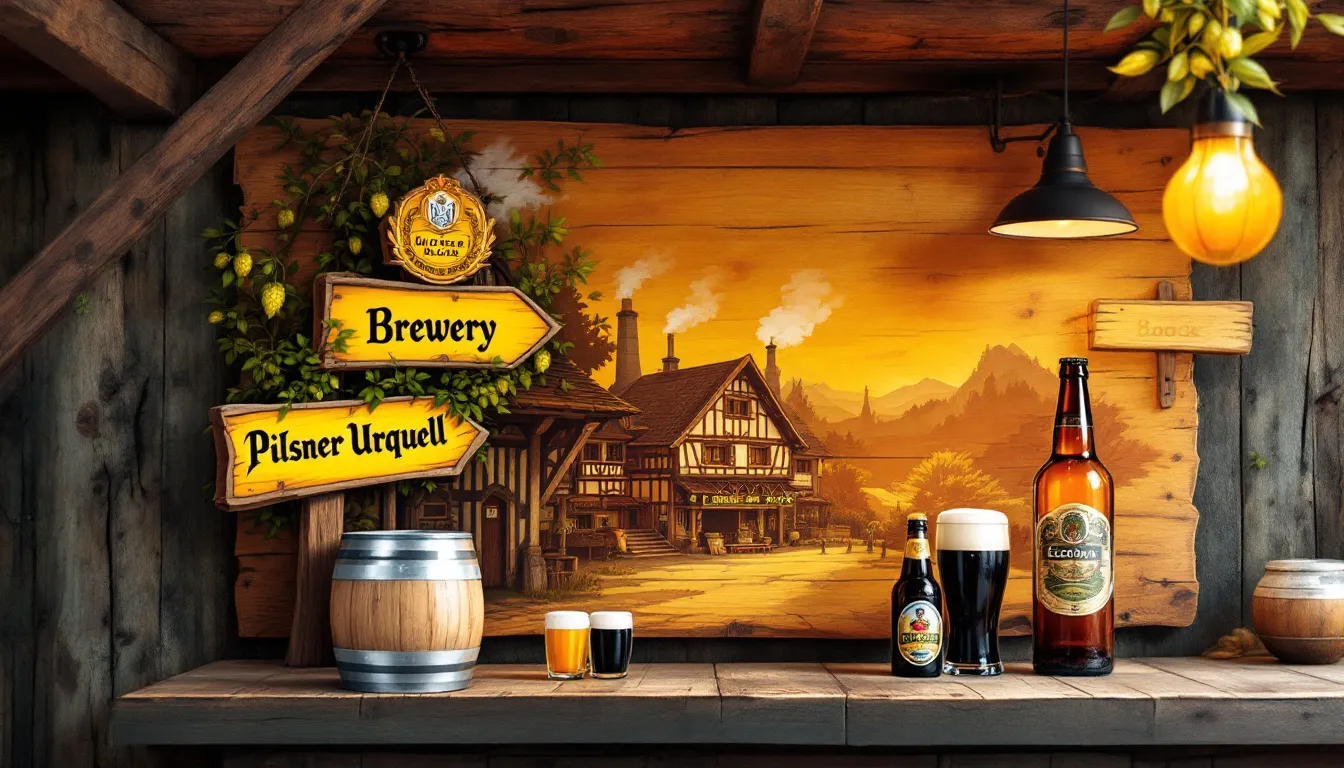
Lager styles are celebrated for their refreshing qualities and global appeal. Unlike ales, lagers are brewed with bottom fermenting yeast at cooler temperatures, resulting in a clean and crisp taste. This makes them a popular choice for those who prefer a lighter and more subtle beer.
Lagers offer a wide range of flavors and styles, from the light and refreshing Pilsner to the rich and malty Bock. Each style has its own unique characteristics, but all share the common trait of being smooth and easy to drink. This versatility makes lagers suitable for various occasions, from casual gatherings to formal events.
In this section, we’ll explore some of the most popular lager styles, including Pilsners, American lagers, and Bocks. Each of these styles has its own distinct flavor profile and brewing process, making them unique and enjoyable in their own way.
We’ll start with Pilsners, known for their pale appearance and hop-forward flavors. Then, we’ll look at American lagers, which are light and crisp, making them perfect for social gatherings. Finally, we’ll delve into Bocks, which are richer and more malty, offering a satisfying drinking experience.
By understanding these popular lager styles, you can better appreciate the diversity and craftsmanship that goes into brewing each type of beer.
Pilsner
Pilsner is known for its pale appearance and is brewed with a focus on hop bitterness and a crisp, refreshing taste. This style of beer originated in the Czech Republic, specifically in the city of Pilsen, and has since become popular worldwide.
Pilsners typically have a light golden color, clear body, and a dry, slightly bitter flavor with a crisp finish. The use of noble hops, such as Saaz, contributes to the herbal and earthy flavor profile that is characteristic of Pilsners.
Before:
Pilsners come in various types. These include American Pilsner, Czech Pilsner, and German Pilsner. Each type has its own unique characteristics, with American Pilsners often being lighter and more refreshing, while Czech and German Pilsners have a more pronounced hop bitterness and a fuller body.
After:
Pilsners come in various types:
American Pilsner, which is often lighter and more refreshing
Czech Pilsner, known for its pronounced hop bitterness
German Pilsner, which has a fuller body
Each type has its own unique characteristics.
Pilsner’s origins in the Czech Republic and its subsequent popularity in Germany highlight the influence of European brewing traditions. The focus on quality ingredients and precise brewing techniques ensures that Pilsners remain a beloved beer style for those who appreciate a clean and refreshing taste.
American Lager
American lagers are known for their crisp taste and clean finish, making them one of the most popular beer styles in the United States. These beers are typically light in flavor and easy to drink, making them a go-to choice for social gatherings and casual occasions.
The light flavor of American lagers is achieved through the use of adjuncts such as corn or rice, which lighten the body and flavor of the beer. This results in a beer that is less bitter and more refreshing, perfect for hot summer days or as a complement to a variety of foods.
American lagers are celebrated for their refreshing qualities, making them a popular choice at social gatherings, barbecues, and sporting events. Their clean and crisp taste makes them versatile and enjoyable in various settings, from casual get-togethers to more formal occasions.
Whether you’re enjoying a cold American lager at a summer barbecue or pairing it with your favorite meal, this beer style offers a refreshing and satisfying drinking experience that is hard to beat.
Bock
Bock beers are characterized by a medium body, certain sweetness, and a distinctive malty component. Originating in Einbeck, Germany, in the 14th century, Bock beers have a rich history and a loyal following among beer enthusiasts.
Bock beers generally have a higher alcohol content compared to other beer styles, giving them a warming quality that makes them perfect for colder weather. The rich malt flavors, often featuring notes of caramel and toffee, create a satisfying and robust drinking experience.
The historical origins of Bock beer in Germany highlight the importance of tradition and craftsmanship in brewing. These beers were originally brewed for special occasions and celebrations, and their rich flavors and higher alcohol content made them a favorite among the German nobility.
Today, Bock beers continue to be enjoyed by those who appreciate their complex flavors and historical significance. Whether you’re sipping a traditional German Bock or a modern interpretation, these beers offer a delightful and satisfying experience.
Specialty Beers and Unique Styles
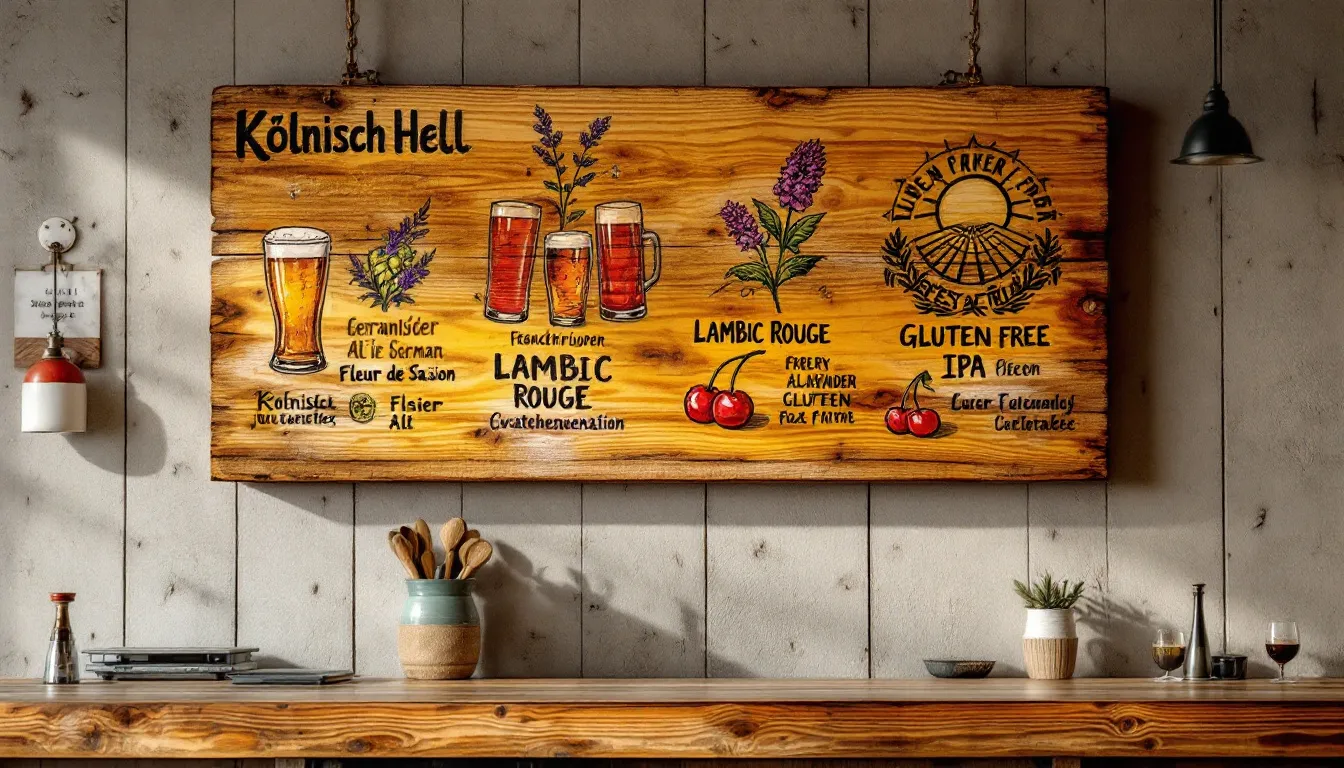
Specialty beers are beers with unique ingredients and brewing techniques that set them apart from standard beer categories. These beers often utilize uncommon brewing methods or ingredients that do not typically fit into standard classifications, resulting in innovative and distinctive flavors.
The first Tripel was brewed by Westmalle brewery in the 1930s, showcasing a unique Belgian style that has since become a favorite among beer enthusiasts. Tripels are known for their high alcohol content and complex flavors, often featuring fruity and spicy notes.
Dubbels, first produced in the Middle Ages, are characterized by a deep amber color and complex flavors such as caramel and figs. These beers were originally brewed by monks and have a rich history and tradition that continues to influence modern brewing.
Doppelbocks are full-bodied beers high in alcohol, with rich flavors including caramel and dried fruit. These beers were traditionally brewed by German monks as a source of nutrition during fasting periods, and their robust flavors and high alcohol content make them a favorite among those who enjoy strong and flavorful beers.
Specialty beers offer a unique and exciting experience for those who enjoy exploring new flavors and brewing techniques. By understanding the history and characteristics of these unique styles, you can better appreciate the creativity and innovation that goes into brewing each one.
Sour Beers
Sour beers are characterized by their tartness, achieved through fermentation with wild yeasts and bacteria. This unique fermentation process creates a complex and refreshing flavor profile that is distinct from other beer styles. Common flavor notes in sour ales include tart, sour, sweet, and fruity, making them a delightful and refreshing choice for those who enjoy bold and tangy flavors. Additionally, sour beer offers a unique experience that appeals to adventurous palates.
The production of Lambic, for example, involves open cooling tanks exposed to wild yeasts and bacteria, allowing for natural fermentation and a unique sour flavor profile. Sour ales come in various styles. Examples include American Brett, Belgian fruit lambic, Belgian gueuze, and Flemish red ale. Each of these styles has its own unique characteristics, from the spontaneous fermentation of Lambic to the mixed fermentation of Oud Bruin and Flemish Red Ale, which create their distinctive sourness.
The use of fruits in sour beers, such as grapes, plums, apricots, and peaches, adds an additional layer of complexity and flavor. Beers like Kriek and Framboise, made with sour cherries and raspberries respectively, showcase the creative possibilities of sour ales and their ability to delight the palate.
Gluten Free Beer
Gluten-free beers are crafted using alternative grains such as sorghum, millet, or rice to accommodate those with gluten sensitivities. These beers provide an important option for people who cannot consume gluten but still want to enjoy the flavors and experience of beer.
Despite using different ingredients, many gluten-free beers maintain a quality and flavor comparable to traditional beers. Brewers have developed techniques to ensure that gluten-free beers can stand up to their gluten-containing counterparts in terms of taste and complexity.
The growing popularity of gluten-free beers has led to an increase in the variety and availability of these products. Today, beer enthusiasts with gluten sensitivities can enjoy a wide range of styles, from light and refreshing lagers to rich and flavorful ales.
Gluten-free beers are a testament to the innovation and inclusivity within the brewing industry, ensuring that everyone can find a beer that suits their taste and dietary needs.
Barrel Aged Beers
Barrel aging involves placing beer into oak barrels that previously held spirits or wine to impart unique flavors. This process creates complex flavor profiles, often exhibiting notes of vanilla, spice, and caramel, influenced by the type of barrel used.
The aging process in barrels can vary significantly, with some barrel aged beers maturing for several months to several years. The length of aging affects the depth and character of the beer, with longer aging times generally resulting in more complex and refined flavors.
Popular styles of barrel aged beers include bourbon barrel stouts, wine barrel aged sours, and rum barrel aged IPAs. These beers are highly sought after for their unique characteristics and the depth of flavor they offer. The influence of the barrel adds an additional layer of complexity that is appreciated by beer enthusiasts.
Barrel aged beers are a prime example of the creativity and craftsmanship that goes into brewing. Understanding the process and barrel flavors deepens appreciation for the artistry behind these exceptional beers.
Cooking with Beer
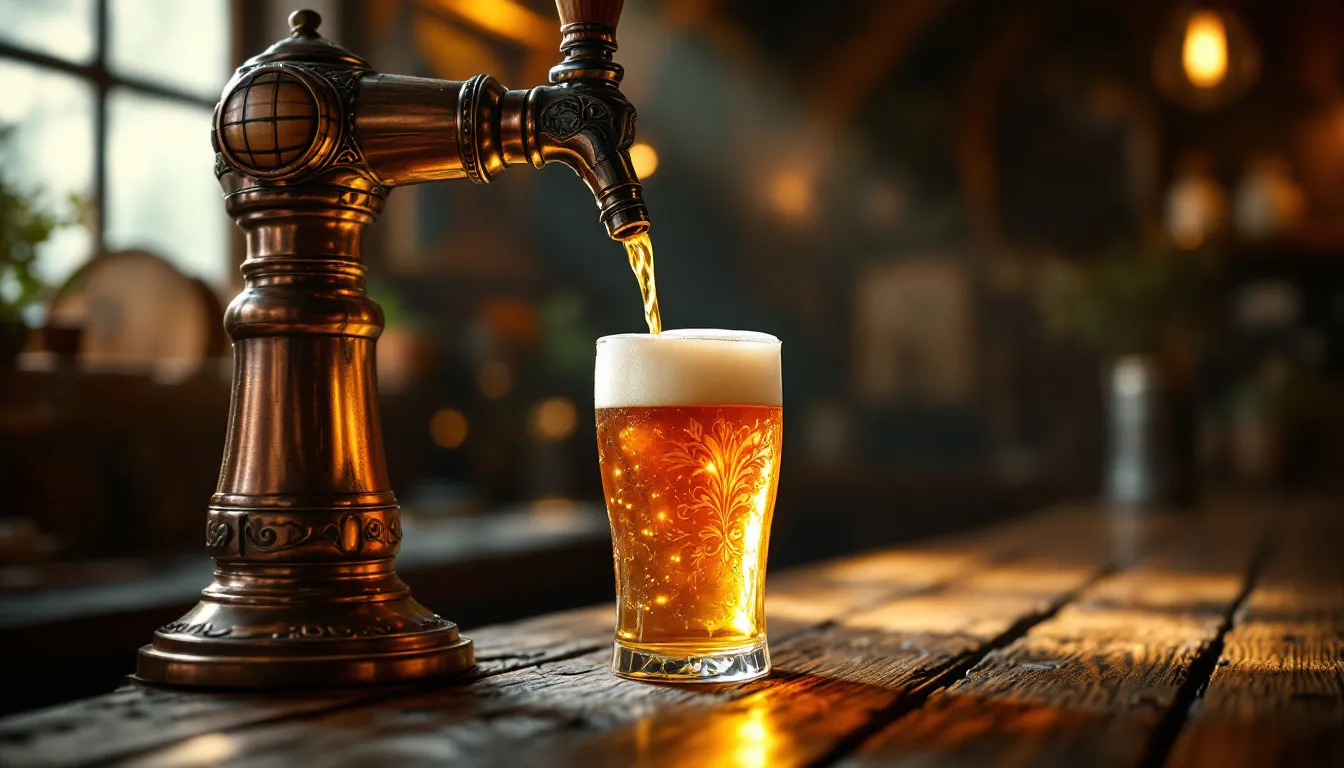
Incorporating beer into cooking can provide a deeper and more earthy taste to various dishes. From enhancing the flavors of a hearty stew to adding a crispy texture to fried foods, beer is a versatile ingredient that can elevate your culinary creations.
Using light beer for frying can result in a crispier and lighter texture in fried foods. The carbonation in the beer helps create a light and airy batter, making it perfect for dishes like beer-battered fish or onion rings.
Beer can be used in both savory and sweet dishes, showcasing its versatility in the kitchen. Whether you’re replacing stock with stout or ale in a soup or stew to add richness, or incorporating dark stout into chocolate-based desserts to enhance their flavor profile, beer offers endless possibilities for culinary exploration.
By understanding how to use different types of beer in cooking, you can create dishes that are both flavorful and unique. This section will explore the best ways to pair beer with food and provide some delicious recipes that incorporate beer as an ingredient.
Pairing Beer with Food
Pairing beer with food can enhance the dining experience by matching flavors and textures. Pale ales, for example, pair well with spicy foods, savory dishes, and roasted meats, thanks to their balanced flavors and moderate hop bitterness.
IPAs complement fried foods, meats, fish, and poultry, with their bold hop flavors and higher bitterness cutting through the richness of these dishes. The robust flavor profile of IPAs makes them a versatile choice for a variety of food pairings.
Stouts are a great match for desserts, grilled meats, and hearty dishes like roasted meats and stews. Their rich, roasted flavors and creamy texture complement the sweetness of desserts and the savory notes of grilled meats.
Wheat beers pair well with salads, seafood, fruit tarts, and vegetables. Their light and refreshing nature, combined with citrusy and tangy notes, makes them a perfect match for lighter dishes.
Recipes Using Beer
Replacing stock with stout or ale in soups and stews can elevate the dish’s richness. The deep, malty flavors of these beers add a layer of complexity that enhances the overall taste of the dish.
Dark stouts can enhance the flavor profile in chocolate-based desserts when used as an ingredient. The roasted malt notes in stouts complement the rich, sweet flavors of chocolate, creating a decadent and flavorful dessert.
Beer can be incorporated into various recipes, showcasing its versatility in enhancing flavors of both savory and sweet dishes. From beer-battered fish to stout brownies, there are countless ways to use beer in your cooking.
Experimenting with various beer types, including chocolate beer, in recipes reveals new and delicious ways to enjoy this versatile beverage.
Choosing the Right Glassware
Selecting the right glassware enhances aroma, flavor, and presentation of different beer styles. The shape and design of the glass can significantly impact your beer-drinking experience, allowing you to fully appreciate the complexity of each beer.
Snifter glasses are perfect for high-alcohol beers, capturing and enhancing their intricate aromas through their shape. The wide bowl and narrow opening help concentrate the aromas, making them ideal for enjoying strong, aromatic beers.
Weizen glasses provide an authentic experience for wheat beers, designed to maintain carbonation and showcase aromas. The tall, slender shape helps keep the beer’s head intact and highlights the beer’s hazy appearance and citrusy notes.
Pint glasses are versatile for various beers, facilitating easy sipping while showcasing the beer’s visual appeal. Whether you’re enjoying a pale ale, stout, or lager, a pint glass is a practical and popular choice for many beer enthusiasts.
How to Pour Different Types of Beer
Pouring beer correctly can enhance its flavors and aromas, creating a more enjoyable drinking experience. The general technique is to pour gently to create a moderate foam head, which helps release the beer’s aromas and improve its taste.
For ales, IPAs, and stouts, pour at a 45-degree angle until the glass is two-thirds full, then straighten to form a good head. This technique helps maintain the beer’s carbonation and enhances its flavor profile.
When pouring lagers and pilsners, start with a slight tilt of the glass and gradually straighten it while pouring to create a head of about 1-1.5 inches. This technique ensures a smooth pour and a consistent head, highlighting the beer’s clarity and crispness.
For wheat beers, it’s helpful to swirl the bottle to mix the yeast before pouring straight down to achieve a thick head. This method enhances the beer’s aromas and showcases its hazy appearance, making for an authentic wheat beer experience.
Summary
Throughout this guide, we’ve explored the diverse and fascinating world of beer, from the fundamental differences between ales and lagers to the unique characteristics of specialty beers. Understanding these various beer styles can greatly enhance your appreciation and enjoyment of beer, allowing you to savor each sip with a deeper knowledge of its origins and flavors.
Ales, with their complex flavor profiles and warm fermentation process, offer a wide range of styles, from the hoppy bitterness of pale ales to the rich, roasted notes of stouts. Lagers, on the other hand, are characterized by their clean and crisp taste, achieved through cooler fermentation and bottom fermenting yeast.
Specialty beers, such as sour ales, gluten-free beers, and barrel aged beers, showcase the creativity and innovation within the brewing industry. These unique styles offer exciting new flavors and experiences for those who enjoy exploring the boundaries of traditional beer categories.
Cooking with beer and pairing it with food opens up a whole new world of culinary possibilities. From enhancing the richness of a stew to creating light and crispy fried foods, beer is a versatile ingredient that can elevate your dishes to new heights.
By choosing the right glassware and pouring beer correctly, you can further enhance your beer-drinking experience, allowing you to fully appreciate the aromas, flavors, and presentation of each beer style. Whether you’re a seasoned beer enthusiast or just beginning your journey, this guide provides the knowledge and inspiration to explore and enjoy the diverse world of beer.
Frequently Asked Questions
What is the main difference between ales and lagers?
The main difference between ales and lagers lies in the type of yeast used during fermentation: ales utilize top-fermenting yeast at warmer temperatures, whereas lagers employ bottom-fermenting yeast at cooler temperatures. This distinction affects their flavor and aroma profiles significantly.
What are some popular styles of ales?
Popular ale styles include pale ales, IPAs, stouts, porters, and wheat beers, each offering a distinct flavor profile and characteristics to explore.
How do you properly pour a wheat beer?
To properly pour a wheat beer, swirl the bottle to mix the yeast, then pour straight down the center of the glass to create a thick head. This technique enhances the beer’s aromas and highlights its characteristic hazy appearance.
What are the benefits of using beer in cooking?
Using beer in cooking enhances flavor depth, enriches soups and stews, and contributes to a crispy texture in fried foods. Its unique taste can elevate both savory and sweet dishes, making it a versatile ingredient in your culinary repertoire.
Why is choosing the right glassware important for beer?
Choosing the right glassware is essential because it enhances the aroma, flavor, and presentation of the beer, allowing you to fully appreciate its complexity and improve your overall drinking experience.

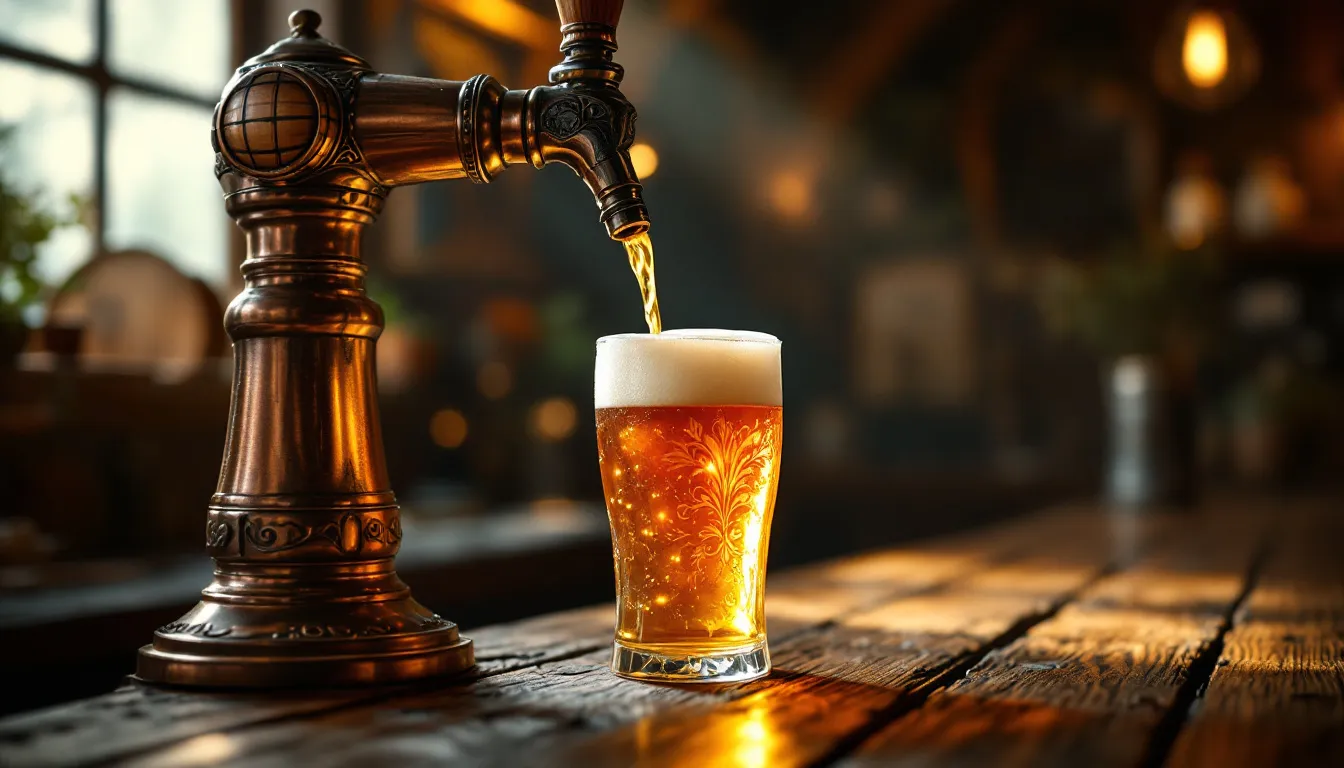
Leave a Reply